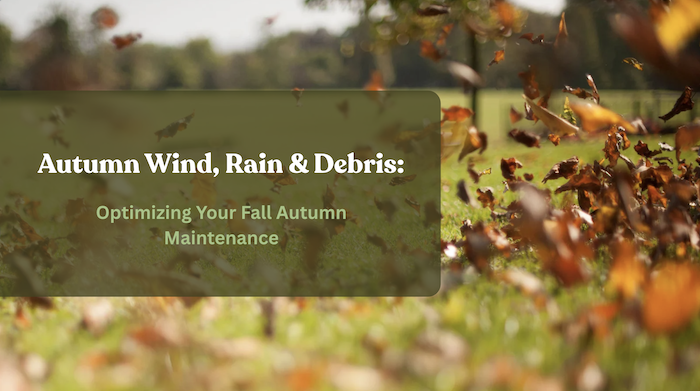As leaves start to fall and the weather turns more unpredictable, autumn presents a new set of challenges for awning owners. Between gusty winds, heavier rains, and debris from trees, your retractable and stationary awnings need extra care to stay in good shape. With timely attention and proper handling, you can protect your investment and extend the life of your awnings well into the colder months.
This guide covers practical steps to prepare for fall weather, maintain your awnings through the season, and transition smoothly toward winter.
Why Fall Maintenance Matters for Awnings
- Frequent wind events: Fall fronts bring stronger gusts, which can stress frames and fabrics if not secured or retracted. See Retractable Awnings.
- Rain and moisture: Prolonged downpours can pool water on fabric, leading to sagging or damage if pitch and tension aren’t correct.
- Falling leaves and debris: Leaves, twigs, and pine needles accumulate on and around awnings, clogging drainage and scratching surfaces. Retractable Screens can also help block wind-driven debris on patios and porches.
- Seasonal transition: Fall is ideal for inspections and small fixes before winter magnifies minor issues. Explore product options on the main Awnings page.
1) Monitor Forecasts & Act in Advance
Retract before high winds: If winds of ~25+ mph are forecast, retract your awning. Extended awnings catch wind like sails and may suffer fabric, arm, or hardware damage. Review wind-ready models on Why Our Retractable Awnings.
Watch for heavy rain: Prolonged or driving rain can cause pooling on flat or insufficiently pitched fabric. Retract or reduce projection when necessary.
Leverage sensors/automation: If you have motion/wind sensors or motorized controls, enable them for auto-retraction during storms. Learn about model and accessory choices within Retractable Awnings and Awning Accessories.
2) Clear Debris Regularly
- Light, frequent cleaning: Use a soft broom or a leaf blower on low to remove leaves, needles, and dust. Avoid sharp tools.
- Mind gutters and downspouts: Keep roof drainage clear so overflow doesn’t dump onto the awning.
- Prune overhead branches: Trim limbs that can drop sap, needles, or branches onto fabric or frames.
- Address stains quickly: Remove droppings or sap before they etch or discolor the fabric.
3) Check Pitch, Tension & Drainage
- Fabric tension: Ensure fabric is taut. Sagging invites pooling and seam stress.
- Proper pitch: Adjust the awning angle so water sheds off the edge rather than collecting in low spots.
- Clear runoff paths: Keep any drip edges or channels free of blockages.
- Patch minor issues: Small tears become big problems under fall storms. Patch/repair promptly.
For guidance on sizing and fit (useful if you’re upgrading or adjusting projection/pitch), see How to Measure for Your Awning.
4) Inspect Frames, Hardware & Mounts
- Tighten fasteners: Temperature swings and vibration can loosen screws/bolts and brackets. Re-tighten as needed.
- Verify alignment: Arms and support bars should be straight. Correct minor bends now.
- Check cables/springs: Look for fraying or corrosion; replace worn parts before they fail under load.
- Assess mounting surfaces: Whether wall, soffit, or roof mounted, confirm the substrate is sound. Explore mounting options within the Retractable Awnings section.
- Lubricate moving parts: A light silicone-safe lubricant helps pivots and rollers operate smoothly.
5) Build a Simple Fall Maintenance Routine
| Timing | Task |
|---|---|
| Early Fall (Sept) | Full inspection (frame, fabric, mounts); clear gutters; prune branches; confirm pitch/tension |
| Throughout Fall (Oct–Nov) | Weekly debris removal; retract before storms; confirm water sheds properly after rains |
| Late Fall (Nov) | Deep clean; patch small damage; schedule any needed service; prep for winter storage/cover |
| After First Frost | Keep awning retracted when not in use; consider a protective boot/cover; spot-check hardware |
6) Prepare for the Winter Transition
- Retract when idle: Keep the unit closed during long, inactive stretches to avoid surprise weather exposure.
- Use protective covers: Ask about off-season protective covers/boots; see Awning Accessories.
- Avoid heavy loads: Don’t allow snow build-up on fabric; keep retracted in wintry conditions.
- Schedule professional help: If anything looked questionable this fall, arrange a service check so you’re ready for spring.
Extend Comfort with Screens & Model Options
If wind or swirling leaves make your patio less enjoyable in autumn, vertical screens can help. Explore Retractable Screens such as The Sentry or Sunroll to add wind buffering, privacy, and debris control while preserving views.
Considering an upgrade? Review core awning lines and specs on Retractable Awnings and product detail pages like The Sunesta. For a broader look at brand offerings, scan the Sunesta Overview.
Why Fall Maintenance Pays Off
- Protects frames, mechanisms, and fabric from seasonal stress
- Prevents costly repairs by addressing small issues early
- Maintains curb appeal and usability into cooler months
- Helps ensure safe, reliable operation when spring returns
Have questions or want a fall checkup? Start with the main Designer Awnings page or contact the team through any product page above.


